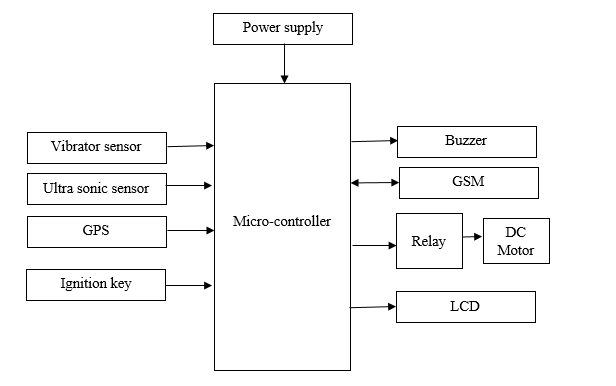Vehicle Theft Detector with Remote Engine Locking
Also Available Domains WSN|Arduino|Raspberry pi
Objective
The main objective of this project is to detect vehicle theft and continuously track latitude and longitude by mobile application
Abstract
The Vehicle Theft Detector with Remote Engine Locking is an intelligent security system equipped with an ARM7 Micro processing Unit (MPU) to ensure the safety of vehicles. It integrates multiple sensors as inputs, including an ignition key sensor for engine ignition control, a vibration sensor to detect vehicle movement, a ultrasonic sensor to monitor fuel levels in the tank, and a GPS module for location tracking. The system offers a comprehensive range of outputs, such as an LCD display for presenting essential information to the owner, a buzzer for alerting theft attempts and notifying low fuel levels, and a GSM module for sending messages to the owner, as well as receiving remote commands to lock the engine. When a command is received from the owner, the Relay and DC motor swiftly halts the vehicle's engine, ensuring security and peace of mind for vehicle owners while effectively deterring theft and unauthorized access.
Keywords: ARM7 micro controller, Ignition key, vibrator sensor, ultrasonic sensor, buzzer, LCD, GSM, DC motor, Relay.
NOTE: Without the concern of our team, please don't submit to the college. This Abstract varies based on student requirements.
Block Diagram

Specifications
Hardware components:
- ARM7 micro controller
- Ignition key
- Vibrator sensor
- Fuel sensor
- Buzzer
- LCD
- GSM
- DC motor
- Relays
Software components:
- Embedded C
- Keil software
Learning Outcomes
- Basic of Embedded C language
- Architecture ARM 7 micro controller
- Interfacing of motor with relay
- Working of GPS
- Working of Vibrator sensor
- Working of ultra sonic sensor
- Working of GSM
- Working of buzzer
- Keil software
- How to install the keil software
- Working of LCD
- Interface LCD with controller?
- Working of power supply
- About Project Development Life Cycle:
- Planning and Requirement Gathering( software’s, Tools, Hardware components, etc.,)
- Schematic preparation
- Code development and debugging
- Hardware development and debugging
- Development of the Project and Output testing
- Practical exposure to:
- Hardware and software tools.
- Solution providing for real time problems.
- Working with team/ individual.
- Work on Creative ideas.
- Project development Skills
- Problem analyzing skills
- Problem solving skills
- Creativity and imaginary skills
- Programming skills
- Deployment
- Testing skills
- Debugging skills
- Project presentation skills
- Thesis writing skills





 Paper Publishing
Paper Publishing
